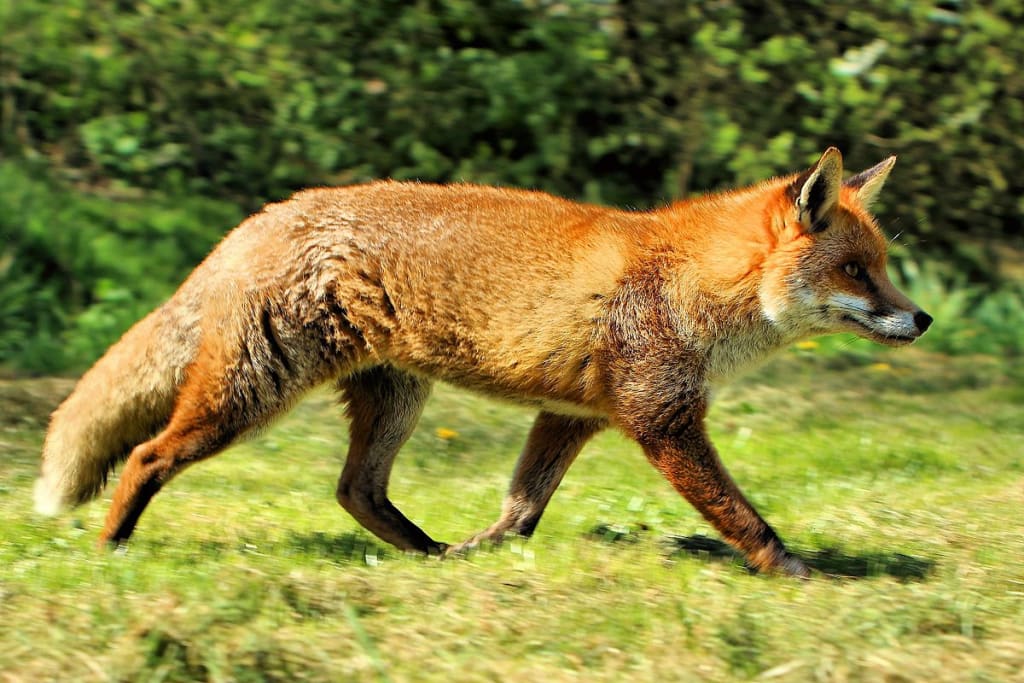
Red foxes have long snouts and red fur across the face, back, sides, and tail. Their throat, chin, and belly are grayish-white. Red foxes have black feet and black-tipped ears that are large and pointy. One of the most noticeable characteristics of the red fox is the fluffy white-tipped tail. Red foxes are about three feet long and two feet tall.
Red foxes are often confused with gray foxes, which share a similar habitat and range. This can make identification difficult, because some red foxes can have large patches of gray fur and gray foxes have patches of red fur. Gray foxes are somewhat smaller and have a slightly more rounded face and shorter snout. The surefire way to tell the difference is to look for the color at the tip of the tail. Gray foxes have black-tipped tails, while red fox tails are white. Although they are very similar in name and appearance, the gray fox and the red fox are only distant cousins, belonging to different genera in the family Canidae.Red foxes can be found throughout the continental United States from Alaska to Florida. The smallest population is in the Southwest, where it is very rare to see a red fox. Red foxes like open areas in woodlands, rural and suburban neighborhoods, wetlands, and brushy fields.Red foxes prefer rodents and rabbits, but they will also eat birds, amphibians, and fruit. Red foxes will also steal food from garbage cans or farms. Their ability to find food, even during the winter, is one reason why red foxes have a reputation for being cunning and smart.Red foxes mate in winter. Right after mating, a female builds a den. Females can deliver anywhere between one and 12 pups per litter. Pups are born brown or gray, usually turning red within about a month. Both parents take care of their offspring until the next fall, when the young foxes set out on their own.Red foxes have adapted well to suburban and rural communities. While other large predators have been pushed away from human development, red foxes took advantage of the changed habitat. They live in parks and woodland edges, and red foxes will readily eat whatever is available. Red foxes are solitary, so it is easy for them to hide and escape people.red fox, (Vulpes vulpes), also called common fox, species of fox (family Canidae) found throughout Europe, temperate Asia, northern Africa, and North America. It has the largest natural distribution of any land mammal except human beings. First introduced to Australia in the 19th century, it has since established itself throughout much of the continent.
Widely held as a symbol of animal cunning, the red fox is the subject of considerable folklore. Physical characteristics
Red foxes are generally about 90–105 cm (36–42 inches) long—about 35–40 cm (14–16 inches) of this being the tail—and stand about 40 cm tall at the shoulder. Most adults weigh about 5–7 kg (10–15 pounds), but the largest individuals may approach 14 kg (31 pounds). The red fox has a coat of long guard hairs and soft fine underfur that is typically a rich reddish brown. Its tail is often white-tipped, and it has black ears and legs. Its colour, however, is variable. In North America, black and silver coats are found, with a variable amount of white or white-banded hair occurring in a black coat, and these animals are sometimes called silver foxes. A form called the cross, or brant, fox is yellowish brown with a black cross extending between the shoulders and down the back. It is found in both North America and the Old World. The Samson fox is a mutant strain of red fox found in northwestern Europe.





Comments
There are no comments for this story
Be the first to respond and start the conversation.